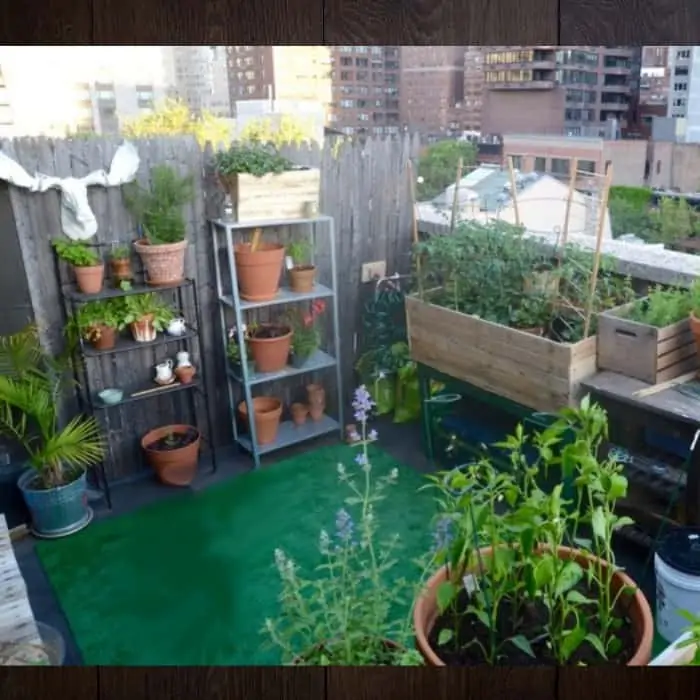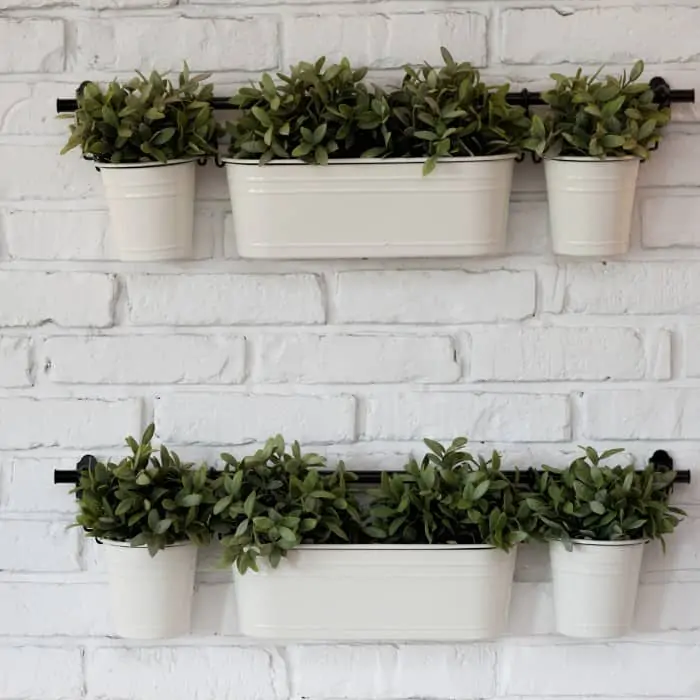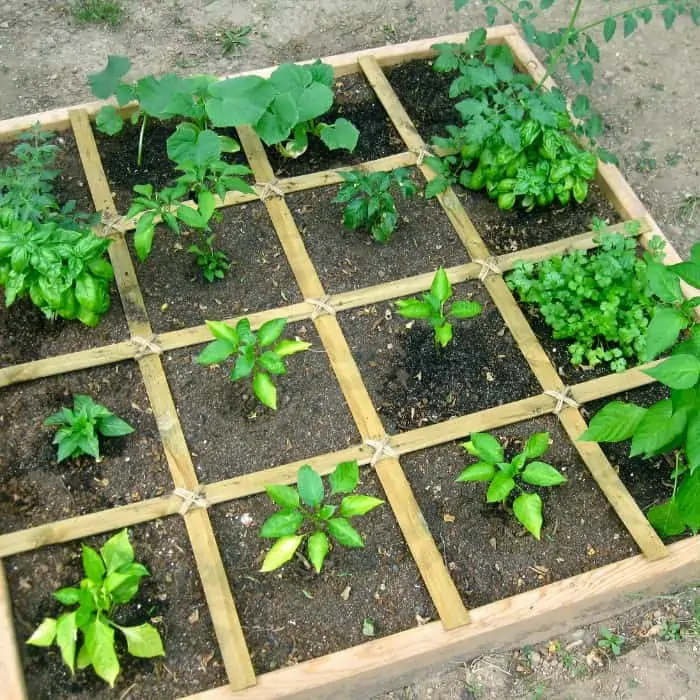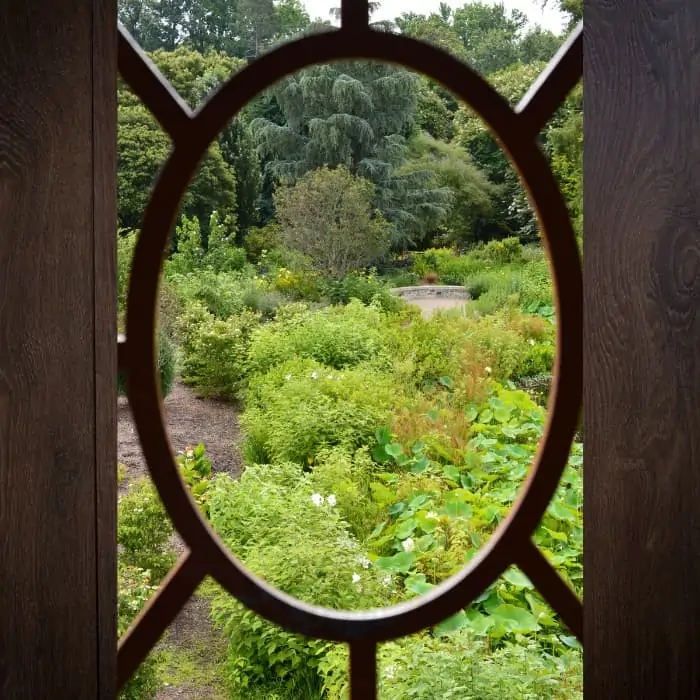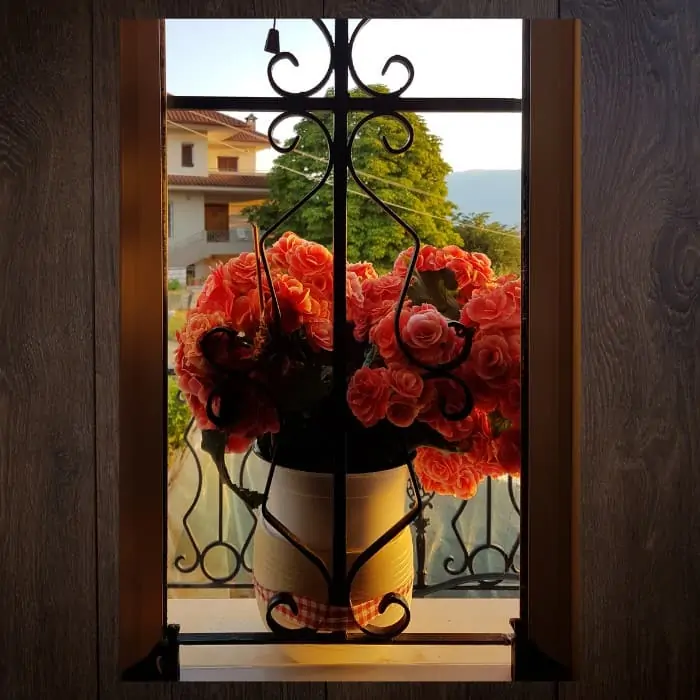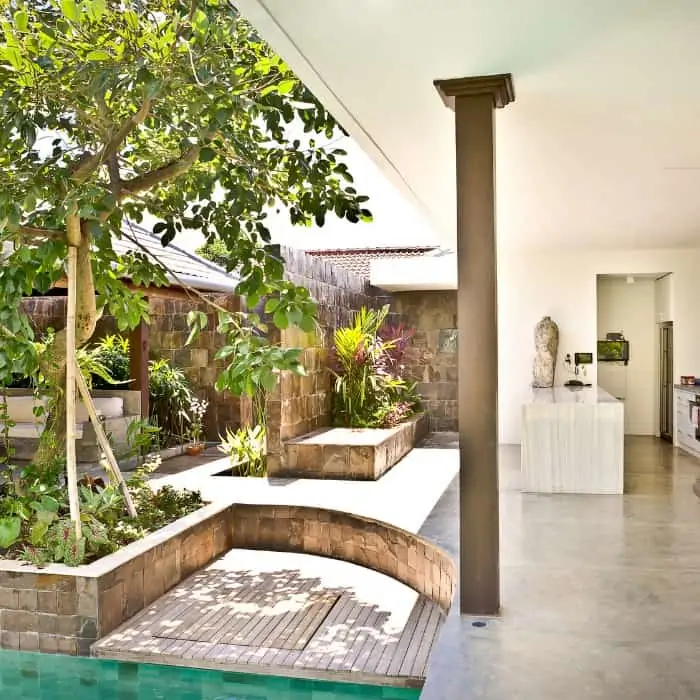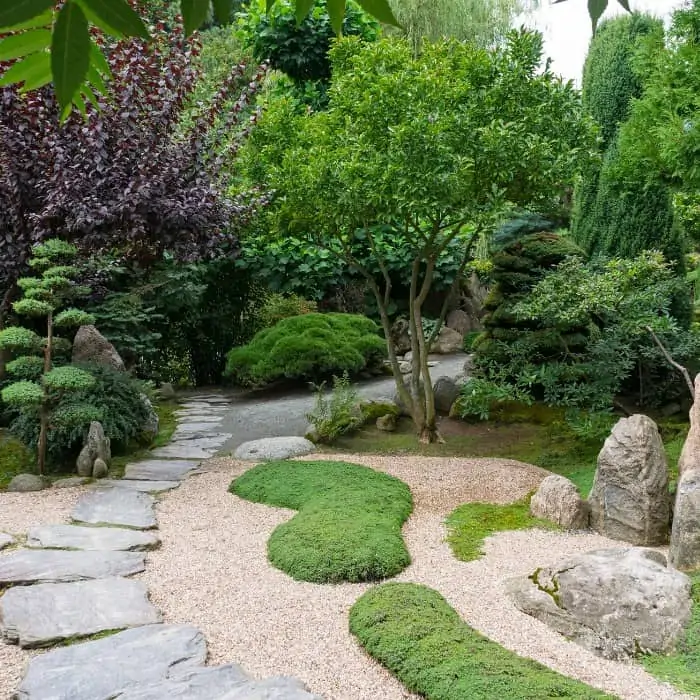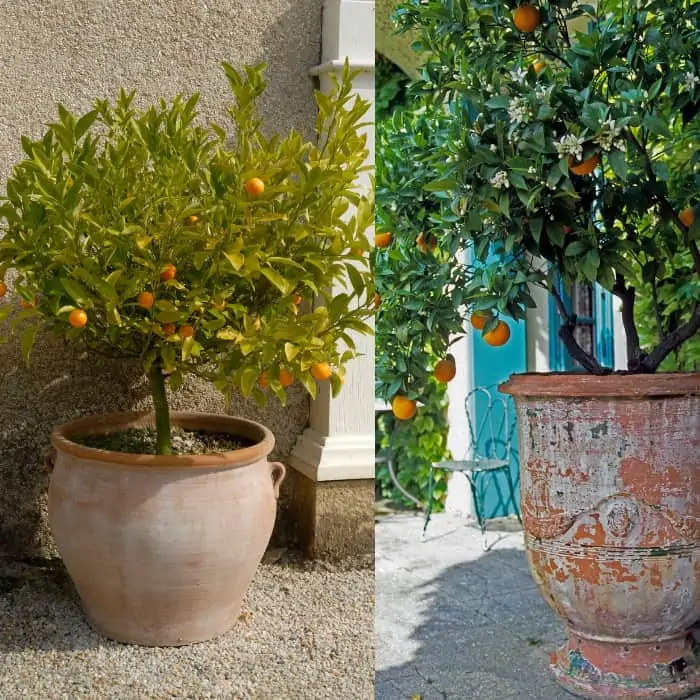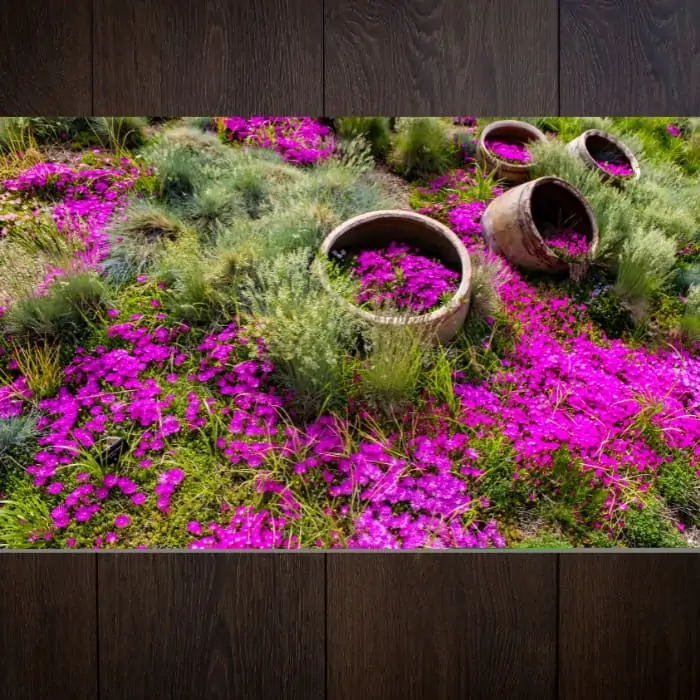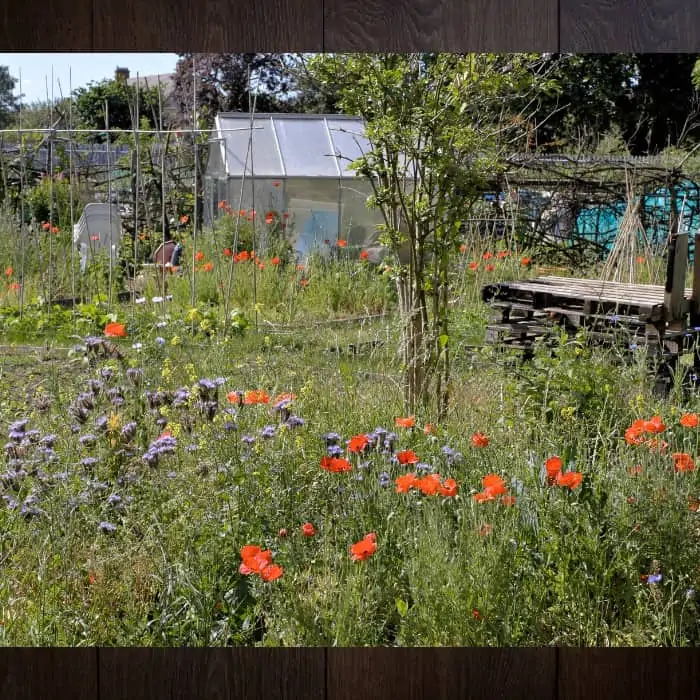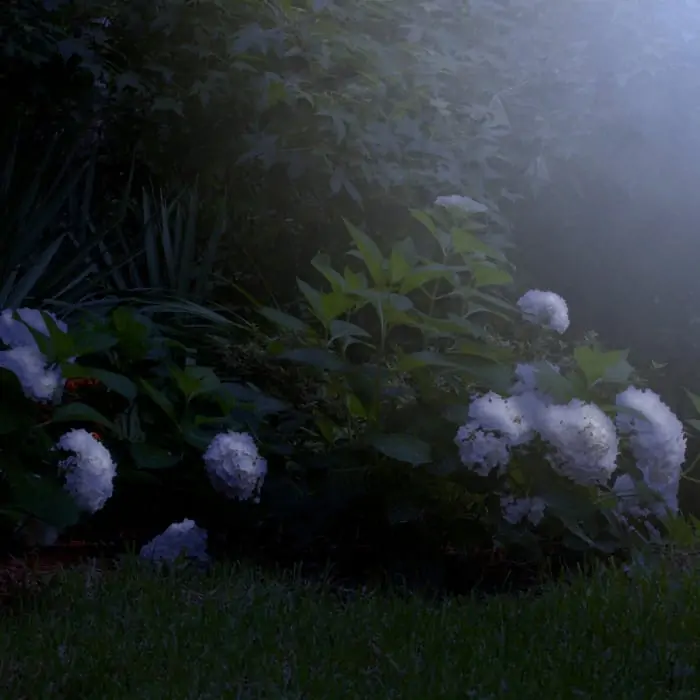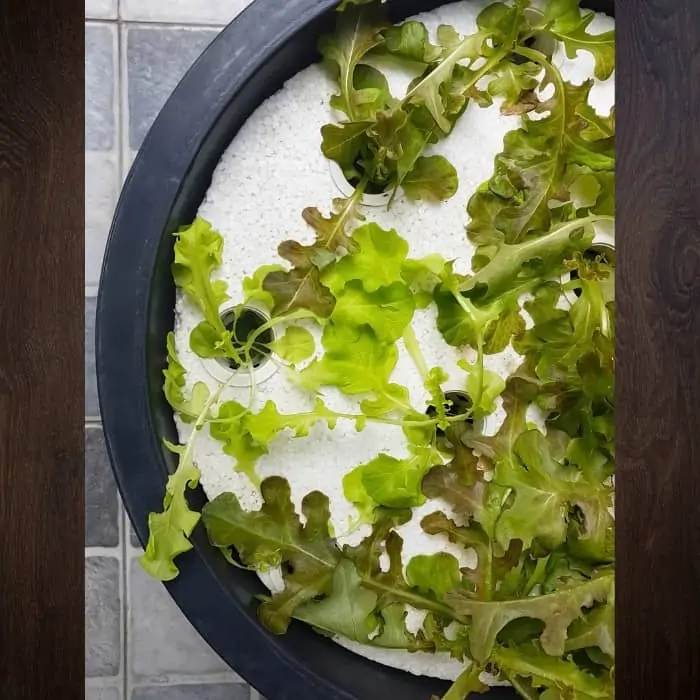It’s a fun time to be a gardener because there are no hard and fast rules anymore. Your garden can have no style at all, or be 15 different types of gardens combined; choosing the best design for your space is ultimately about how the result makes you feel. The best part is that modern design techniques mean we don’t have to worry the way we used to about things like irrigation systems or how long things take to grow.
Modern day French gardens rely heavily on clipped hedges, geometric shapes, symmetry, and lines. They are beautiful, but extremely maintenance-heavy.
There are multiple workarounds for all scenarios, so much so, you can even overhaul your garden and try new looks surprisingly frequently. Here are 25 of my favorite types of gardens, from new and trendy, to classic standbys, to unique takes on dated ideas. Try one, or try them all.
Contents
Edible Gardens
As the name would imply, edible gardens are all about growing things for consumption, and they’re super easy to adapt to gardens of all shapes and sizes. Traditional fruit and vegetable gardens are the most well-known examples, but there are other types of gardens in this category worth considering.
1 – Cocktail Garden
The balcony of a NewYork apartment is a perfect location for this cocktail garden.
A somewhat recent fad in gardening is growing ingredients for your drinks. A lot of people grow a cocktail garden with alcoholic beverages in mind, but it works just as well for non-alcoholic drinks too . Herbs like mint, rosemary, lavender, and sage are good selections because they enhance a huge flavor profile. Berries – blueberry, strawberry and raspberry, to name a few — are also good choices for these types of gardens. All of these plants look great on their own or together, they grow well in the ground or in containers, and they can be a small part of a big garden, or the only garden you have. My favorite thing to make with ingredients from a cocktail garden is spa water, which is a great way to make plain water more appealing and increase your water intake. Try any of these recipes on a warm day, especially #3.
2 – Herb Wall Garden
Herb wall gardens can live indoors or outdoors. You can purchase complete kits that have everything you need, including the seeds.
The herbs you use for these types of gardens can be as traditional or rare as you want them to be. What makes this design extra fun is the level of creativity you can unleash. If an all-white set is too vanilla for you, use whatever you have around the house. Glass mason jars, whole or sections of pallets, old wicker baskets cut in half, a shower caddy, and even a pocketed hanging shoe organizer can all be fashioned into herb gardens with a cool, industrial feel. Shade-tolerant herbs like chives, parsley, and tarragon mean these can live inside or outside or anywhere in-between.
3 – Salad Garden
No matter what style of garden you currently have, you can design a salad garden to enhance the visual appeal.
If you love fresh green salads, this one is a must-try. All your favorite salad ingredients like cucumber, tomato, pepper, radish, onion, and a nice mix of lettuce, spinach and arugula are grown together in a designated space, either in-ground, in a raised planter bed, or in a container. The ingredients list can be scaled up or down, depending on how much room you have. And don’t forget that vegetables are sun-lovers, and most lettuces are short-day plants, so these types of gardens need 6-8 hours and 10-12 hours of direct sunlight a day, respectively.
4 – Salsa Garden
No salsa garden is complete without cilantro. Be sure to choose slow-bolt varieties if growing for the leaves (and not the seed).
Fresh, homemade food is almost always better than the pre-made versions you can buy at the store. This is particularly true for salsa and pico de gallo. You can always immediately tell the difference, because you can literally taste the freshness. The base ingredients are the same for pretty much any salsa: tomatoes, onions, cilantro, lime (dwarf key limes are delicious and perfect for small areas), and maybe even some garlic. The variable is the chile. Grow jalapeno, Anaheim, or poblano chiles for a mild heat, and serranos or habaneros if you like it hot. Even if you don’t eat the peppers, they’re beautiful and colorful little plants and make such an interesting addition to most types of gardens. As most edible gardens do, these types of gardens lend themselves well to small spaces either in-ground or in a container. With some extra finesse, you can even get these to grow indoors.
5 – Square-foot Garden
A typical square foot garden bed is 4-feet by 4-feet, with the interior divided into 16 equal squares.
Square-foot gardens take traditional vegetable gardens and scale them down to typically a 4′ x 4′ square planter bed that’s been divided into 16 smaller squares, each exactly 12″ x 12″. The squares are marked off with thin twine or wood slats, and each holds a specific number of a specific species. The concept of these types of gardens works great as long as the guidelines — which rely heavily on companion planting, assign quantities based on size, and require that each adjacent square have a different “crop”- are followed. For example, cabbage, broccoli and peppers are one plant per square; leaf lettuce, swiss chard, and parsley are four per square; spinach, bush beans, and beets are nine to a square; and carrots, radish, and onion are 16 to a square. The concept has been around for decades, but with sustainable and DIY gardening’s recent trendiness, it’s enjoying a rebirth. These types of gardens are perfect for small spaces like balconies and rooftops.
Concept Gardens
It’s all in the name. Concept gardens are just that — gardens that are built entirely around one or two very specific and typically very noticeable design concepts. If less-traditional types of gardens and brand new trends appeal to you, give one (or all) of these a try.
6 – Vignette Garden
A vignette garden can be as detailed and meticulously planned out as this…
…or as perfectly simple as this.
I love this concept. Vignette types of gardens are all about being on the inside looking out. Imagine being inside your living room or kitchen and looking out the window into your garden. The view that you see of your garden through the window is the “vignette”; that’s the vantage point you should have in mind when designing that space. The goal is to be able to look up at any time from the kitchen sink, or maybe while soaking in a hot bath in your bathroom, and see something beautiful. The view can be of a detailed landscape with layers of depth and complex compositions, or of a simple vase with a bouquet of flowers.
7 – Monochrome Garden
Monochrome gardens not only feature plant material within one color family, site amenities and furnishings are often of that color family, too.
A garden designed around one single color is a monochrome garden. But rather than choosing one exact shade, monochrome types of gardens choose a color family, and then incorporate various hues and levels of saturation. Everything in the garden is in that color family, and there’s no such thing as too much. When these are done well, the result is breathtaking, and anything but boring. The key is to use different shades and textures, and don’t just think in terms of plants and flowers. Seats, benches, pots, and other site amenities can be in your color family, too.
8 – Indoor/Outdoor Garden
If designed well, indoor/outdoor gardens transition so seamlessly, you can’t be sure if you’re inside or outside.
There’s a design concept called “biophilic design,” which uses architecture to create a physical feeling of connection with nature. These types of gardens have no hard transitions between inside and outside; the transition is so blurred, one might not even know which one they’re in. The easiest ways to accomplish this are to arrange furniture in the same formations and use the same color schemes and textiles. Inspiration is also drawn from Scandinavian focus on year-round outdoor living, which is achieved partly by making indoor comforts available outside. Think large throw blankets, soft pillows, a pizza oven, and ceiling fans.
9 – Minimalist Garden
Sansevieria (shown) is a great choice for a minimalist garden. It’s interesting enough but doesn’t overshadow any other design elements.
The goal of a minimalist garden is to foster a sense of calm and unencumbered peace. So it doesn’t mean creating an empty, stark space; it means being very intentional with the elements you do choose for the space, ensuring they’re simple, neutral, and follow clean, straight lines. Pots in one color family, using more hardscape elements such as rock instead of grass, and plants that are straight and simple in architecture (like candelilla, horsetail reed, or ‘sticks of fire’ for a pop of color) are the hallmarks of a minimalist garden design. A monochrome palette is perfect for these types of gardens.
10 – Asian-inspired Garden
Asian-inspired gardens use flowering cherry trees, Japanese maples, bamboo and ginkgo.
Asian landscapes are known for being serene and creating a sense of Zen. While some design elements are open to interpretation, these types of gardens use a plant palette that’s iconically Asian. For example, flowering cherry trees, Japanese maples, bamboo, and ginkgo should be included. Another important element is the presence of actual or the feeling of simulated meandering pathways. These can be created with stepping stones or with the addition of a river rock dry creek bed. Ultimately, it’s important not to overdo any one element, or the overall finished design. Less is definitely more in an Asian garden.
Elemental Gardens
Earth, wind, water, and fire: they are the four elements of all matter on Earth. These types of gardens show their appreciation and respect for one or more of those elements through interpretive landscape design. Whether it’s leaving a smaller footprint, incorporating nature into your self-care routine, or reducing wildfire risk, you can express your environmental consciousness with these types of gardens.
11 – Self-sustaining Garden
Self-sustaining gardens can take any shape or form you want, but must follow some basic philosophies: they benefit the health of the earth, they encourage community involvement, and any unneeded surplus is regularly and freely shared with neighbors and other community members.
Self-sustaining gardens fall under the “permaculture” umbrella, which is a concept that aims to create not so much a garden but an ecosystem, where people and plants co-exist harmoniously and self-sufficiently. They’re meant to stand the test of time, feeding not only those who planted it, but all those who come after them. These types of gardens can be designed and executed however you see fit, as long as they follow three basic tenets: they must not harm the earth in any way, and should in fact be beneficial to it; they encourage community involvement; and they follow the “fair share” concept of taking only what you need and sharing the rest (giving away surplus).
12 – Rewilded Garden
If going full-rewilded is too unkempt for you, consider maintaining your lawn but allowing the border to rewild. It’s a compromise that creates an interesting contrast that is nice to look at.
A garden that’s been rewilded is one that’s gotten away from heavy cultivation and maintenance techniques and been allowed to return, at least partially, to what it would look like in nature. It’s a concept that focuses on using all-native plants (no alien species), plants that attract birds, bees, butterflies, and other pollinators, and naturally-created green “waste” (fallen wood, leaves, etc.) that we might normally rake up and throw away. If the idea of letting your entire garden go wild gives you anxiety, remember, you can designate smaller spaces within the garden to this concept; you don’t have to go all-in. These types of gardens are good ways to begin a transition from a formal, heavily manicured garden to something more natural.
13 – Rain Garden
A typical lawn area rain garden is a deep depression disguised by native, water-absorbing plant material. The depression, at first glance, goes unnoticed.
As our population expands, so do neighborhoods and communities, and these expanding city infrastructures mean less natural ground and more solid surfaces. Unable to soak up water, these solid surfaces have contributed to the problem of polluted lakes and rivers, which in turn cost these cities exorbitant amounts of money to treat. That’s where rain types of gardens come in. They’re large depressions in your front or back yard (depending on where water runs and collects on your property) that act as catch basins; the water is collected in these areas instead of free-flowing down the streets and absorbed into the earth. The areas are “disguised” with a palette of water-absorbing shrubs, creating a mini landscape within your landscape. The EPA has created a database of rainwater-absorbing plants by state, and by multiple regions within a state, to help you select the appropriate palette.
14 – Aromatherapy Garden
Though easily adaptable to a large space, aromatherapy gardens are perfect for container-gardeners with limited space. Any plant and herb you’d want in your aromatherapy garden does just fine in a pot
…including the wonderfully-fragranced sweet orange tree, an aromatherapy garden must-have.
Our sense of smell is a powerful thing. From being able to conjure up intense memories and experiences, to changing our physical and mental states of well-being, aromatics can be intensely effective. The only requirement for these types of gardens is to use plant material that appeals to your sense of smell and achieves the desired result. Lavender, creosote, rosemary, mint, gardenia, sweet acacia, citronella, orange, tangerine, and patchouli are all wonderfully fragrant options. The garden itself can be large or small, in the ground or in containers, inside or outside, and as diverse or species-specific as you prefer. You can simply enjoy these gardens in their planted state, or take it a step further and harvest them to make essential oils. Amy Rodquist-Kodet, the University of Kentucky’s Wellness Specialist and Health Coach, published an aromatherapy handout that breaks down which plants and herbs treat which ailments, with recipes to get you started.
15 – Fire-safe Garden
Ice plant (Delosperma spp.) is considered a fire-retardant plant and are a good addition to a fire-safe garden.
If you live in a place like California, a fire-safe landscape might appeal to you. There are no fire-proof plants, but there are those that are fire-resistant. You want high moisture, drought-tolerant, low-growing plants with a low sap-content. Some fire-resistant options include hedging roses, bush honeysuckles, currants, cotoneaster, sumac, and shrub apples. There are also fire-retardant plants: rockrose, ice plant and aloe are a few examples. This kind of plant palette combined with other measures such as using stone work as much as possible (walls, patios, walkways, decks, etc.) and planting hardwood trees instead of conifers make fire-safe types of gardens good strategies to resist the spread of fire to your home.
Green-only Gardens
Maybe it’s the look, or maybe it’s allergies, but not everyone likes or can tolerate flowers. Thankfully, that doesn’t mean gardening has to be taken off the table. These types of gardens are nothing but glorious green as far as the eye can see. Well, maybe some yellows, reds, and purples, too. But the point is: no flowers!
16 – Succulent Garden
A succulent garden is a great way to spruce up an existing landscape that needs some pizazz. A collection of succulents in a mix of containers can easily be placed into any garden.
Succulents do flower, technically, but in cultivation many of them won’t. It’s a common complaint about them, so thankfully that won’t be an issue in this case. These types of gardens are adaptable to just about any location and condition; from tiny indoor spaces to large outdoor landscapes, there’s a succulent that will grow and look perfect. If you have a large outdoor space to fill, look for larger species like aloes, agaves, some euphorbias, and some echeverias. Jade plants, sedum, sempervivum, string of pearls, and aeoniums are all good options for smaller spaces. Succulents can be a little high-maintenance at first, and especially if they aren’t in the conditions they like best. The two big things with these are to give them lots of warmth and well-drained soil that gets nice and dry between waterings.
17 – Rainforest Garden
Even dry, low-precipitation climates can enjoy a rainforest garden. The garden shown here is green and lush, and full of heat-loving, drought-tolerant plants acclimated to an arid region.
Rainforest types of gardens can certainly be adapted to include flowering plants and trees, but for our purposes here we are looking at plants that are foliage-only. Unless you live in an actual rainforest, the standard plant palette may or may not work for your climate. These plants like warm and humid conditions, so, in regions that can’t provide both, you have to work with the options available to you. Look for plants with oversized waxy leaves, lots of green, and of varying heights. Just about any type of palm tree is a good choice. Windmill and Mediterranean fan palms are cold-hardy down to 5-degrees. Umbrella plants, Japanese silver grass, mandevilla, some types of yucca, and hostas are all tropical looking plants that will survive into zone 5. Gardenia.net is a great resource for plant ideas, and it’s entire database is categorized by zone.
18 – Grass Garden
Ornamental grasses are versatile plants that can enhance many different styles. An island of natural-growing grasses can give a riparian vibe, while a single specimen in an ornate planter (inset) looks more formal.
As you might surmise from the name, these types of gardens use only ornamental grasses to make a visually impactful statement. If this sounds boring, that may be because you haven’t seen the extent of the variety in the ornamental grass family. Tall ones, short ones, mounded ones, spiky ones, purple ones, pink ones, sun ones, shade ones … You get the idea. Grasses are very adaptable and look right at home in any style of landscape. They have a rare dichotomous element to their architecture that allows them to both blend into a background or be a showstopping focal point. A cluster of standard pink pampas grass can get over 10′ tall, almost as wide, with a massive “canopy” of showy pink plumes, making it an interesting choice instead of a small tree. Heavily hardscaped and minimalist gardens look stunning with individual grasses evenly spaced in containers or recesses. They are even a great fit for a huge, open space — a mass planting of one species in the entire space creates an effect that’s almost plain, but in an inexplicably intriguing way.
Flower-focused Gardens
To many, green-only and minimalist types of gardens defy the whole point of gardening. After all, what is a garden without flowers? If bright, colorful, aromatic flowers of all shapes and sizes are your thing, these gardens are for you.
19- English Garden
English gardens know how to multitask. Clipped hedges, manicured lawns with sharp edging, and a fair amount of hardscape including container plantings are common. Large trees framing the house and a heavy mix of profusely-blooming annuals and perennials look just wild enough to keep it all from feeling too stuffy.
An English garden design is fun to start with because it gives you a lot of wiggle room. There are the formal and manicured gardens we might associate with a posh society, and then there are the informal cottage gardens that look more natural. One thing all English types of gardens have in common is their implementation of a little bit of everything. So if you want to do an English garden design, make sure you include a lawn, hedges, and drifts and borders with clusters of bright flowers, herbs, and grasses. Whether you go with informal or formal, the plantings should be dense and lush, to soften the many hard pathways and structures.
20 – Cutting Garden
Fast-growing lilies (background) and tulips (foreground) are two flowers you will definitely want in your cutting garden.
Cutting gardens are extremely satisfying for those who love making and seeing flower arrangements. There’s a lot of flexibility here – these types of gardens can take up the entirety of a large, spacious garden, be one small section of it, or be confined to containers on a balcony. The more space you alot, the more options you’ll have for the types of arrangements you make. Just remember to stagger your cutting so your garden still has blooms to show after you cut. If your space and therefore palette are limited, focus on getting fast-growers. Sweet peas, lilies, sunflowers, tulips, gladiolus, and roses are all fast-growing flowers perfect for cutting gardens. Here are some tips from a florist on keeping your cut flowers alive as long as possible.
21 – Wildflower Garden
Don’t be fooled by the appearance of a cultivated wildflower garden. It takes a lot of planning and careful execution to go from manicured to wild.
While these types of gardens can be scaled up or down to accommodate any space, they’re a particularly useful and low-maintenance way of covering wide expanses of open lawns and fields. But they don’t start low-maintenance. In fact, they’re quite a bit more work to get going than you might expect, but more than worth it in the long run. It’s much more than just tossing out some seeds and walking away. The first thing you want to do is find the location on your property that gets the most amount of sun. Just as important as location is how you prepare the ground. All of the existing vegetation should be removed, and if you really want to set yourself up for success, perform a solarization treatment as well. Mix the seeds with sand, spread, rake, and water, and you should have germination in 2-3 weeks. Blooms will follow about 5-6 weeks later.
After-dark Gardens
Enjoying your garden doesn’t have to end when the sun goes down; in fact, for some, that’s an ideal time to start enjoying it. These types of gardens can be designed exclusively for nighttime use or to pull double-duty and seamlessly blend day-use into night-use.
22 – Luminous Garden
String lights (left) and paper globe lights (right) are super-easy and beautiful ways to create ambient lighting. Create a vignette with string lights on a ladder, or string globe lanterns under tree canopies. Or better yet, do both.
When the sun goes down, this normal-garden-by-day comes (even more) to life thanks to the good old fashioned power of electricity. If you can light it, it’s lit, and the whole thing comes together easily by the push of a button or insertion of a plug into an outlet. These types of gardens create a space that’s both warm and inviting, and also a tinge other-worldly and ethereal.
Downward-hanging pendant lights affixed to a mossy, willowy tree creates a stunning effect.
It’s easy to accomplish that with soft, twinkling white lights.
Fairy lights on lattice-work, draped over hedging, and wrapped around a defoliated tree take this seating area from daytime pretty to nighttime stunning.
Other ways to light the space could be: hang pendant lights over a seating area for ambient lighting during an outdoor meal; compliment the light from a fire pit by adding fairy lights to an adjacent shrub and a trio of lit candles off to the side; weave soft yellow globe lights in and out of a hedge to give the impression it’s glowing from within; or hang string lights streamer-style over a pool or water feature.
23 – Moon Garden
Moon gardens can be very moving and personal experiences for people. There is nothing quite like the way the moon reflects the sun.
Moon gardens are also meant to be enjoyed primarily at night, but they accomplish this without any artificial lighting whatsoever. Instead, these types of gardens rely on the brilliance of stark white and silver flowers and foliage that seem to glow under the moonlight. Chosen also for their fragrance, these flowers create an overall magical, immersive experience meant to draw you in and keep you…at least for a little while. It’s not an experience you rush; rather, the ideal vantage point is from a comfortable chair or sitting area in the heart of the garden, where you can relax, close your eyes, and forget the outside world for a bit. White roses, night-blooming jasmine, moonflower, tuberose, cyclamen, white lilies, white peonies, and white hyacinth are all perfect for a moon garden.
Indoor Gardens
Even those who have absolutely zero outdoor space whatsoever can still enjoy the benefits of gardening. These types of gardens are specifically designed to live their entire lives in an indoor container or vessel. That said, they can be adapted to living outside either on their own or as part of a bigger, more traditional in-ground garden.
24 – Fairy Garden
Fairy gardens make creative use of everyday garden materials, including using tiny plants and pieces of plants to simulate huge shrubs and towering trees.
These types of gardens are a fun and unique way to introduce children to gardening, and they’re a creative outlet for adults with a whimsical side. There are a lot of different parts, many of which aren’t plants, that you can make or purchase. As far as plant material goes, a groundcover is essential. Mosses work well, as do miniature ivy and scleranthus. Next, you’ll need a small-stature plant: marigolds, coleus, and lily of the valley are fairy garden favorites. Many people also include foxtail ferns and succulents like jade or portulaca. Lastly, include something colorful and attractive to butterflies and birds. Snapdragons, cosmos, and bee balm work well. Once you have all your components, your fairy garden can be put together in the ground around the base of an existing tree, or in an existing herb garden. They can also be built into various receptacles like planter pots, wheelbarrows, wash tubs, old tires, window boxes, or even hollowed out tree stumps. At this point, the details are entirely up to your imagination. If you prefer an indoor garden, simply adjust the planet palette.
25 – Hydroponic Garden
A hydroponic garden can easily be fashioned with a plastic receptacle and piece of styrofoam. Don’t forget to add nutrients to the water.
Hydroponics is gardening without soil, using nutrient-rich water as the medium. A lot of people prefer hydroponic gardening over traditional gardening because, apart from avoiding messy soil, the plants grow faster, have better yields, and have fewer issues with diseases and pests. These types of gardens are relatively easy to get started with; there are a lot of options available to you, so it can be as basic or involved as you’re wanting to get. Pre-assembled kits are available for purchase of varying sizes, or you can also build your own system or piece something together out of items you have at home. Coleus, dahlias, geranium, jade, basil, cilantro, lotus, watercress, and even watermelon are all great plants for hydroponic gardening.

Jack founded our blog after two decades of working in the pest control industry. His vast experience dealing with a wide array of pests allows him to diagnose issues quickly and get to the heart of pest problems quickly and effectively. He has serviced more than 2,000 homes over his career and there is hardly any pest situation that he has not seen before.

